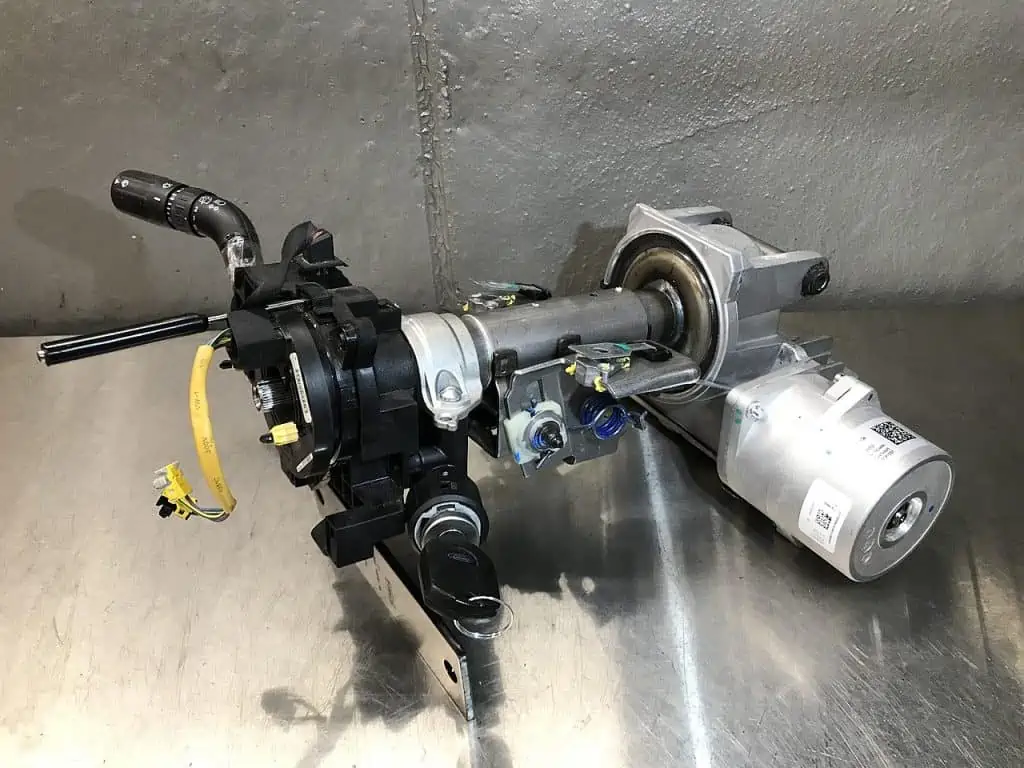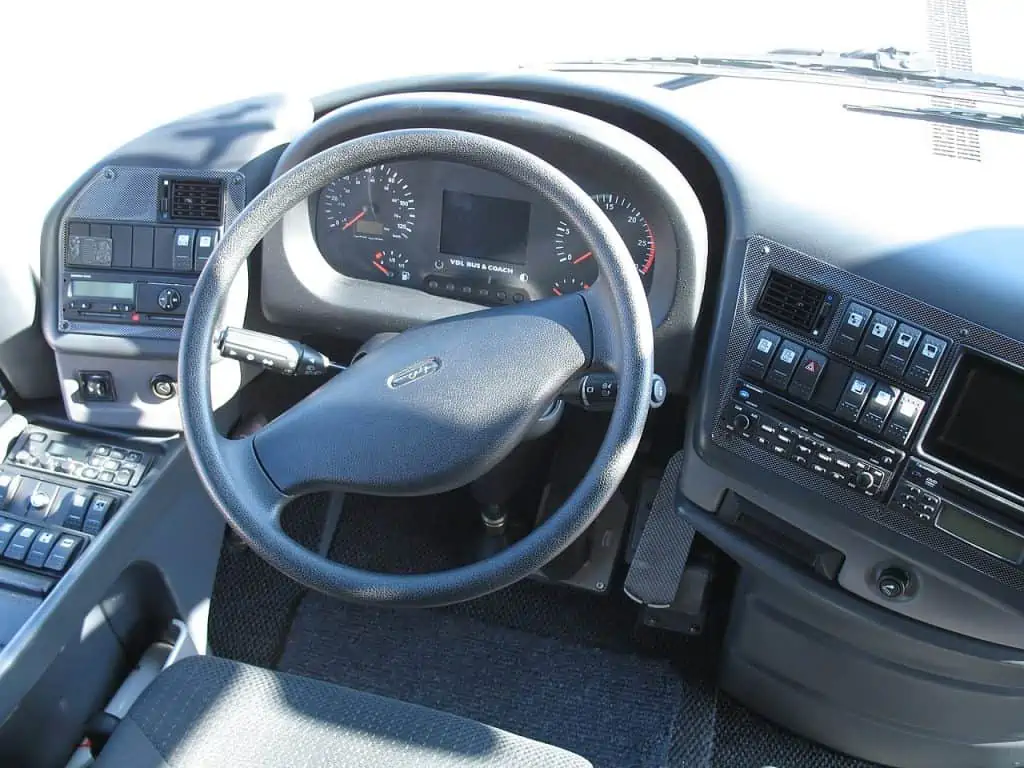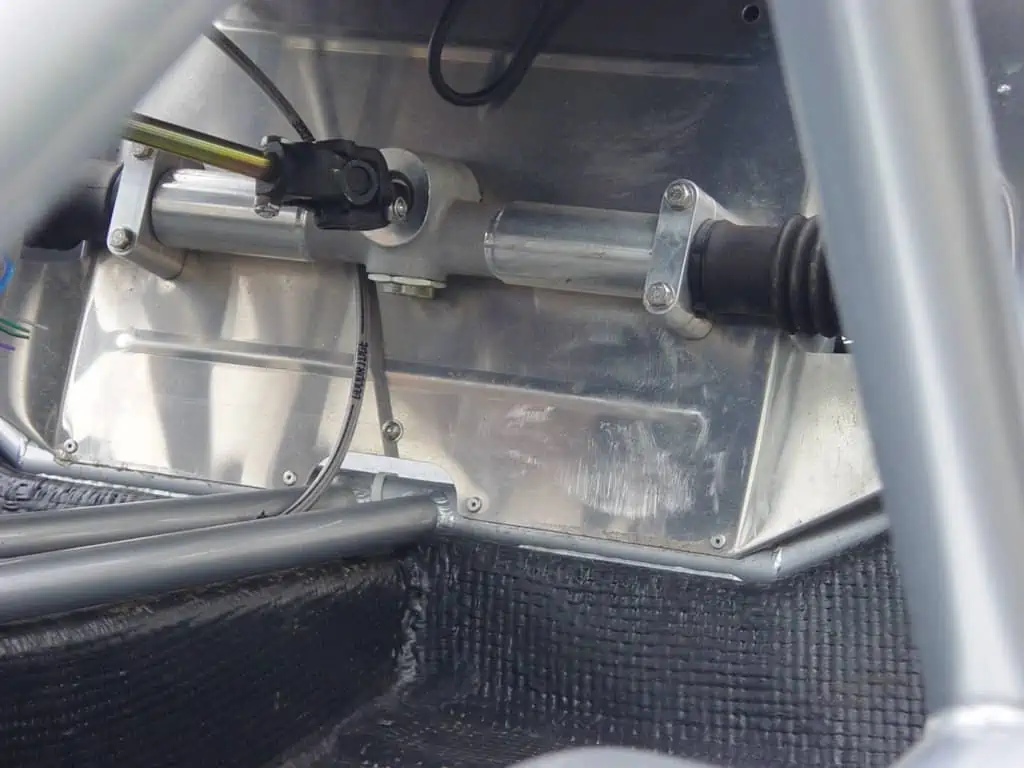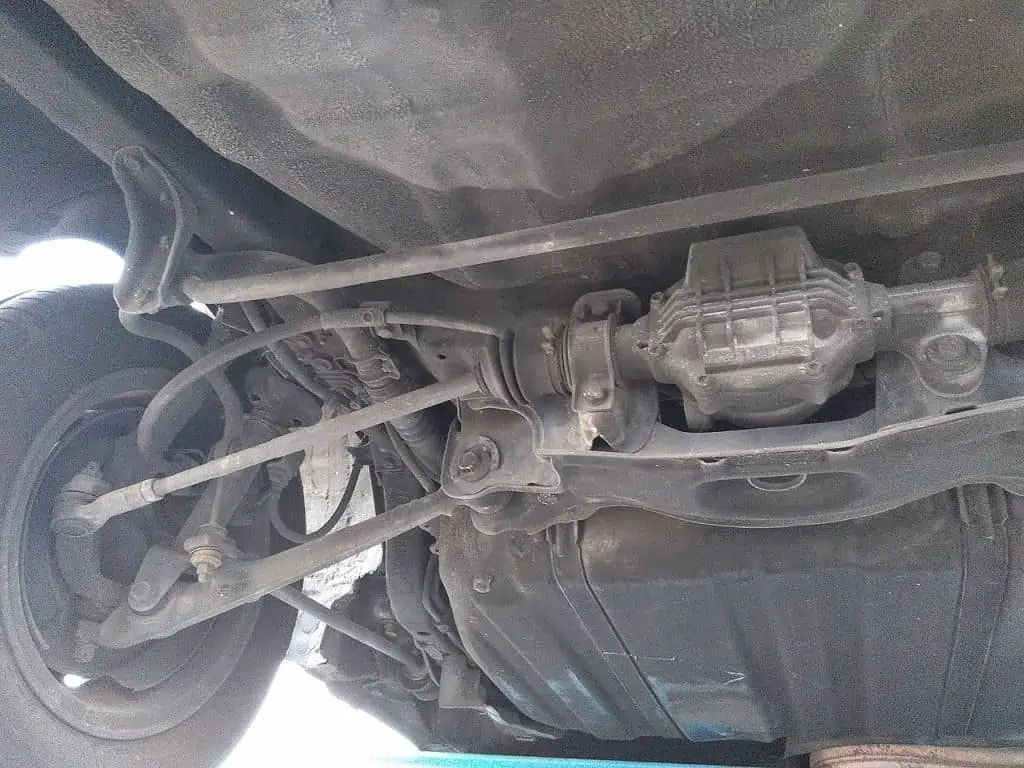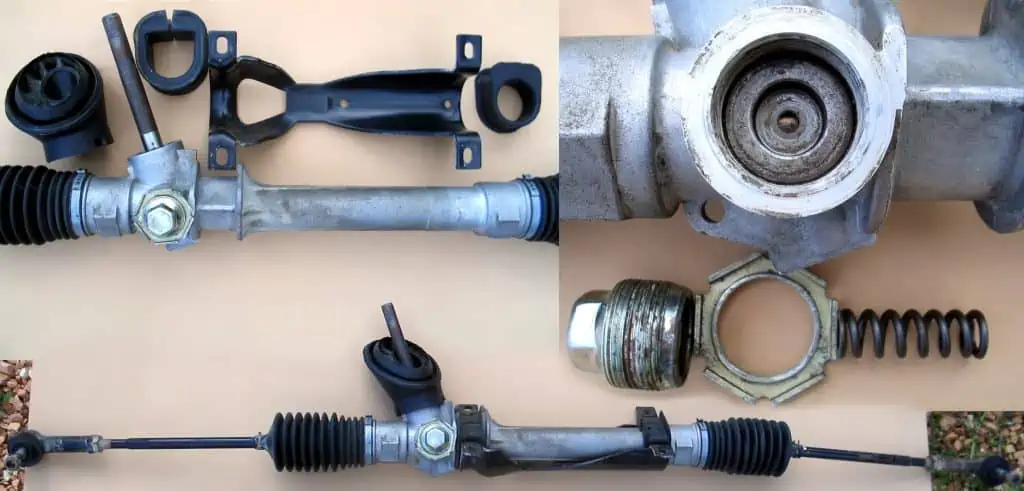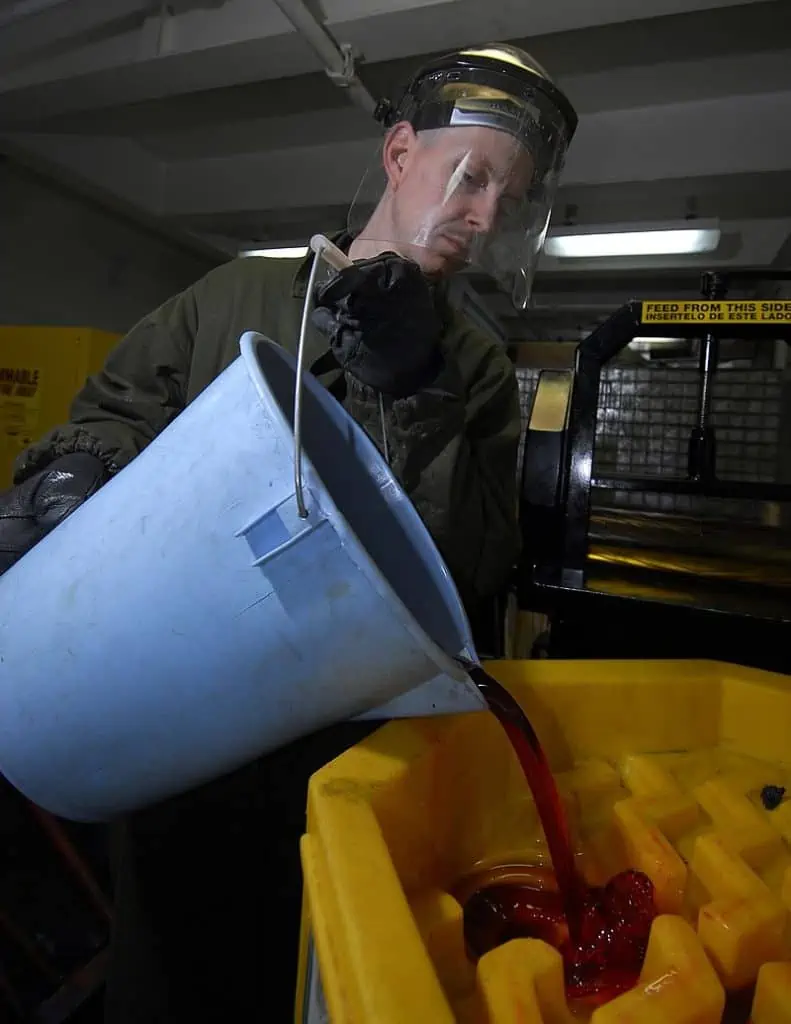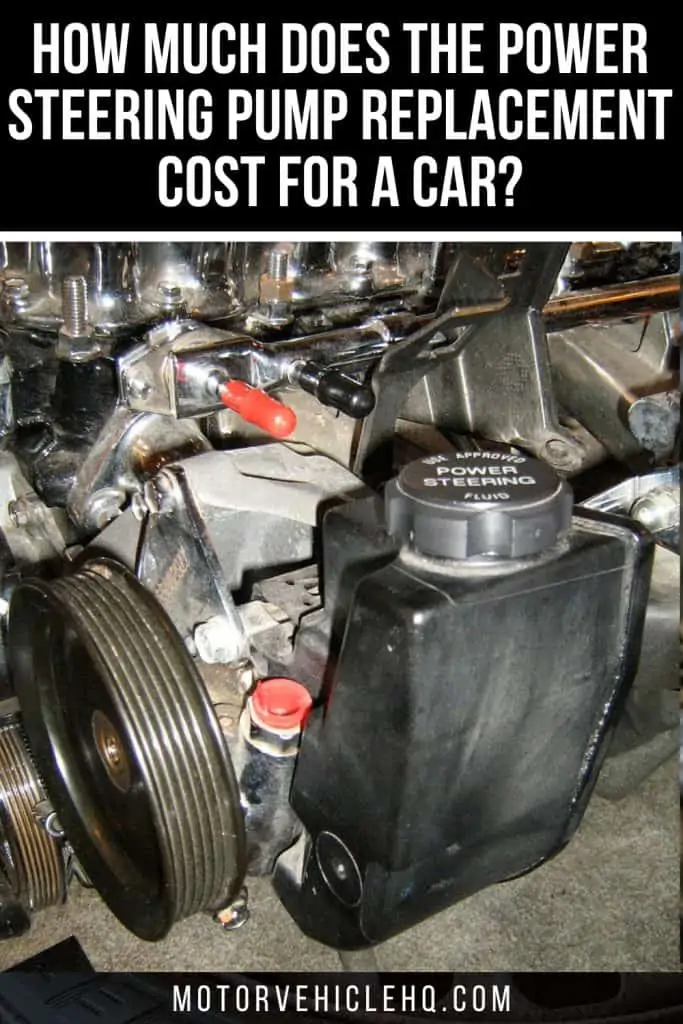The power steering pump is particularly crucial for a comfortable ride, even though every component of your car is essential to its proper operation and best performance.
The hydraulic fluid that assists the driver in turning the steering wheel is pressurized by the power-steering pump mechanism. The steering system won’t function properly if this isn’t operating at its best.
If you hear whining, screaming, or grinding noises when steering or turning the wheel, you might want to check your car’s power steering pump. If necessary, think about a power steering pump replacement.
Today, the power steering system is usually included in the engine of modern cars. You no longer have to stress over making quick turns and having smooth steering because of this hydraulic steering system.
You would only be able to ignore the buttery steering until the power steering pump replacement call is made. This is so that you won’t end yourself on the rocks if it fails!
The power steering system, like other parts of your car, uses mechanical gimmicks to ensure that you have to exert the least amount of physical effort when steering.
This implies that the power steering pump is susceptible to failure and may eventually require power steering pump replacement.
The power steering pump may occasionally sustain damage or degrade over time. The inability to direct the car effectively may result in a significant problem or an accident. A car’s typical power steering pump replacement expense ranges from $598 to $851.
A Power Steering Pump: What Is It?
You might want to start by considering why older automobile models are more difficult to steer than more recent ones. It’s because older vehicles lacked what is today known as a power steering system.
You may wish to check the input shaft of the pump in addition to the fluid reservoir tank. If you want to be thorough in your search for leaks, you might also want to look for fluid drips inside the lower sections.
Now, not being able to use power steering does not preclude you from steering at all. Even yet, the steering system was designed to turn more easily with the help of a pump thanks to further developments in hydraulics.
One of the more important components of a car’s hydraulic steering system, which replaces the power steering assembly, is the power steering pump. The integrated pump’s function is to apply the necessary pressure to the steering fluid to ensure that it circulates and moves in the desired direction.
The fluid is kept in a reservoir, and when it travels through a hose to the pump, it powers a mechanism that turns the wheels. The fluid is then moved away from the pump, regenerating pressure. Additionally, a flow restrictor is present, turning the pump’s output to provide a particular amount of resistance.
The rack and pinions, accessories that create and transform a circular motion into a linear one, are among the other parts of the power steering pump system. These components are what turn the wheels.
A Power Steering Pump: How Does It Work?
When your cars are moving, the power steering pump is supposed to run continuously. Due to how comfortable driving can be, this is especially well-liked among drivers. The pump balances the vacuum in addition to managing and sustaining thinner fluids at greater pressures.
With the aid of the hydraulics-driven power steering pump, you may cruise around without grunting and with little physical exertion on the steering. If your car has power steering, the power steering pump and its operation are crucial components of the engine system.
A malfunctioning pump system is a sign that you might need to get a power steering pump replacement right away. This is crucial for both smooth, noise-free driving and safety issues.
But how would you know when to restart your power steering pump, anyway? To learn the precise symptoms of a bad power steering pump, steer clear to the following section.
Which are the Common Bad Power Steering Pump Symptoms In a Car?
Now that you know what a power steering pump is used for, you may understand why having one that is in good operating order is so important. As a result, it can also highlight the dangers a malfunctioning pump system poses when you’re on the road.
The power steering pump, which uses hydraulic mechanisms together with electrical machinery, ages and degrades over time just like other parts of the car. To properly maintain it, regular upkeep is required.
While many are confused about the warning signs and symptoms of a bad power steering pump system, others are worried about the repair and replacement prices of the power steering structure. How can you tell when it has to be replaced?
When you are behind the wheel, keep an eye out for the following telltale signs:
An EPS module with a partially disassembled steering column by Samf4u / CC BY-SA 4.0. A stiff steering wheel indicates a completely failing steering pump. If you notice that the steering wheel is stiff, you may want to swiftly come to a stop for safety even if you are in the midst of a long road.
1. You Have a Rigid and Unstable Steering Wheel
The mechanical component of the steering pump is where the primary problem is. Therefore, a more obvious symptom that you might see is while your hands are on the steering wheel. You may receive a direct warning if you steer in one way and your automobile turns a little bit more slowly.
In the worst-case scenarios, the car may completely cease turning, which can be very dangerous. Your steering wheel may need to have its pump replaced if it feels stiff and sluggish. Steering would be more challenging at slower speeds.
However, you might want to be aware that a hard steering wheel is a symptom that your steering pump has completely failed. Even if you are in the middle of a lengthy road, if you discover that the steering wheel is rigid, you may want to quickly come to a stop for safety.
The erratic steering wheel is frequently referred to as “steering wander” by technicians. Changes in the fluid hydraulics, together with other factors such as belt displacement, can contribute to steering instability.
2. You Notice Leaks In The Power Steering Fluid
The power steering fluid must go through the hose, valves, pistons, and of course, the pump itself to provide the necessary pressure for the power steering pump to operate at its best.
The power steering pump may malfunction if you notice that the fluid’s level or color has changed. Typically, the fluid is pink, transparent, or red in hue. You might detect gray toner all by itself with chrome accents to alert you to the need for an upcoming power steering pump replacement.
The leak may occasionally be as obvious as fluid spilling from the engine to the ground. The connection that this pressurizing liquid establishes between the steering wheel and the wheel that spins will be broken if there is not enough fluid.
Power steering fluids can lubricate moving elements as well, so a leak might potentially reduce the steering system’s overall performance.
3. A Squealing Noise Coming from the Hood Can Be Heard
One of the most obvious and significant indicators that your power steering pump needs to be replaced right away is the loud and screaming noise it makes whenever you turn the engine. The noise is not only excruciatingly annoying, but it also indicates that the system belt needs to be realigned.
The power steering pump fluids are inadequate, which causes the slip or shift in the slip belt. The pump automatically starts to circulate the power steering fluid when you turn on your car’s engine.
Without enough fluid, the circulation cannot be completed, which causes the timing belt to be displaced. This in turn causes all the screaming noises to come from under the hood, alerting you to the need for a power steering pump replacement.
Along with inspecting the fluid reservoir tank, you might also want to pay attention to the pump’s input shaft. You might also wish to check for fluid drops inside the bellow if you want to be completely thorough in your search for leaks.
The steering wheel by Lukas 3z / CC BY-SA 4.0. Even with a hard steering wheel, you can continue to drive for a few hours without running the major risk of an accident. However, by doing so, you unwittingly put your power steering system in danger of long-term damage.
4. Whining, Knocking, and Other Sounds Can Be Heard
There are a few more noises you could hear to inform yourself about the state of your power steering pump and whether it needs to be replaced, aside from the loud and recognizable squealing noise when the engine is started.
It is important to note that your steering pump system’s fluid level is crucial. Every time you steer, a certain whining noise will let you know if the fluids are low. The main cause of the low fluid levels is a pump leak.
Most people frequently disregard the sporadic knocking noise coming from under the engine bay. However, before your power steering pump completely quits, this is one of the final cautions it will issue.
You might anticipate grunting sounds when driving if you need a power steering pump replacement. Grunting or groaning noises are difficult to ignore, therefore a driver’s ears are always alert for them. This is yet another indication that there are problems with the power steering fluid and that you need to replace the power steering pump.
Is It Safe to Drive a Car with a Faulty Power Steering Pump?
What’s all the fuss about then, if the steering wheel requires a little more effort to turn on the roads and makes a few grunting noises? Many drivers are willing to put up with problematic steering behaviors to avoid paying for the power steering pump replacement that comes with changing it.
However, doing so is extremely dangerous because you could suffer a serious accident while attempting to move the stiff steering wheel or deal with the leaking fluids.
You may want to tow to the side of the road or a repair shop as soon as one is in sight if you suspect the whining sounds are originating from under the hood or the grunting noise is more than just an occasional warning signal.
You can still drive for a few hours when the steering wheel is rigid without running the serious risk of an accident. But by doing so, you unintentionally endanger your power steering system with ongoing harm.
The mechanical assembly and the fluid-pump system are two of the engine’s most crucial components.
If you continue to drive a car with a defective pump system, there is a considerable chance of the timing belt snapping at any point because of erratic pressure circulation caused by low fluid levels. This would only result in you being stuck somewhere on the road with your vehicle.
You can always do it yourself if the extra costs are delaying the power steering pump replacement!
How Much Does the Power Steering Pump Replacement Cost?
Before considering the cost of a power steering pump replacement, one reacts immediately to the warning signals of a failing power steering pump. The cost of the power steering pump replacement is significant, but it is unquestionably less expensive than rebuilding the complete engine or purchasing a brand-new vehicle.
The usual cost to replace a power steering pump can range from $100 to $250 for the parts, and from $200 to $300 for the mechanic’s time. Depending on several factors, you might have to spend up to $600 if more parts need to be fixed or replaced.
The steering rack and pinion by Leonard G. / CC SA 1.0. The power steering pump system also includes the rack and pinions, accessories that generate and convert a circular motion into a linear one. The wheels are turned by these parts.
The cost of replacing your power steering assemblies will vary depending on several factors. Your car’s make, model, and of course the particular design are the main determining factors.
The cost to replace the power steering pump in a Honda Civic is from $396 to $527, while the cost to do it in a Chevrolet Silverado ranges from $364 to $647.
The availability factor would be relevant depending on the car model you are driving and whether it is a newer or an older model. Parts are easily accessible and less expensive to replace on newer versions.
As we all know, how much your repair shops and neighborhood mechanics charge will depend on how long it takes them to do the job and, more crucially, the city and region you live in.
Prices for Selective Power-Steering Components
- $200 to $600 for a power steering pump
- $150 to $250 for a tank reservoir
- $100 to $300 for a pump hose
- $300 and above for rack and pinion
How Can I Reduce the Cost of Power Steering Pump Replacement?
We understand that the expense of the power steering pump replacement together with the additional labor cost can cause you to lose sleep over your bills, regardless of the model or the city or region you live in. As a result, we investigated how you may use it to slightly lower the costs associated with power steering pump replacement.
By purchasing the replacement parts on your own and delegating the physical labor of the repairs to the mechanic, you can reduce the hefty prices. If your local shops are out of stock, you can search the aftermarket for less expensive items, although shipping costs will apply.
You can also save an additional $300 by performing the power steering pump replacement yourself. Videos and how-to manuals can help you if you are handy and have experience with mechanical car maintenance. You might also ask a buddy who has experience with mechanical repairs and replacements for assistance.
However, it is always advisable to spend the extra labor charges for professional assistance if you are dubious about your mechanic skills.
Power Steering Pump Replacement Example Costs
Although there is an average price range for power steering pumps, the cost of power steering pump replacement varies depending on the make and model of the vehicle. Let’s discuss a few popular vehicles and their entire power steering pump replacement expenses, which can change based on the type of vehicle.
1. The Ford F-Series
First, labor for the Ford F-Series model normally costs between $197 and $251 and parts typically cost between $144 and 185. For this Ford, the power steering pump will set you back between $341 and $436.
Honda Prelude Mk III rear steering box by Soyuz72 / CC BY-SA 4.0. Modern cars typically come with a power steering system built into the engine. This hydraulic steering system takes the worry off of making rapid turns and having smooth handling.
2. The Chevrolet Silverado
Next, labor costs for the Chevrolet Silverado range from $189 to $241 while part costs range from $175 to $406. As you can see, there is a significant variation in the cost of the individual parts, expanding the range of the overall average price, and increasing the cost of the power steering pump to $364–647.
3. The Ford Focus
The Ford Focus, a different Ford vehicle, has gained popularity recently. For this vehicle, labor costs range from $126 to $161, and parts cost between $141 and $173.
The overall cost of the power steering pump now ranges from $267 to $334, making it one of the lowest total rates for power steering pump replacement costs. You might feel more secure selling your Ford Focus for cash if it has been recalled.
4. Toyota Corolla and Camry
We talk about the Toyota Camry and the Toyota Corolla as we introduce a new Toyota brand. Costs for labor and parts are the same for the Toyota Camry and Corolla.
Both models’ labor costs range from $150 to $191 while component costs range from $204 to $409. The overall cost of the power steering pump ranges from $354 to $600, demonstrating a significant difference between the low and high end of the pricing range.
5. The Nissan Altima
The Nissan Altima, the sole Nissan on this list, serves as our fifth vehicle. The labor costs for Nissan are incredibly low, averaging $94–121 per hour.
The cost of the parts, which ranges from $246 to $298 on average, is one of the highest on this list. The Nissan Altima’s power steering pump will set you back between $340 and $419.
6. The Honda Comparison
The Honda CR-V, Honda Civic, and Honda Accord are the final three vehicles on our list. These three cars range widely in price, unlike the Toyota vehicles.
Both the Honda CR-V and the Accord have extremely low labor expenses, ranging from $39 to $50 and $71 to $90, respectively. However, the Civic’s labor costs are outrageously high at $213 to $271.
The cost of the Honda automobile parts varies a lot as well. A fantastic alternative if these costs are too high for you is to sell your Honda for cash.
The parts for the Honda CR-V cost between $392 and $622, whereas those for the Civic and Accord only cost between $183 and 256 and $155 and $349, respectively.
The Honda Accord has the lowest overall power steering pump cost, ranging from $226 to $439, while the Civic is in the center, costing $396 to $527. The Honda CR-V has the most expensive power steering pump costs, ranging from $431 to $672.
Which are the Power Steering Pump Replacement Benefits?
If you want to try steering and directing your moving vehicle, a power steering fluid is essential. You won’t be able to move your wheel easily without steering fluid, and the steering mechanism will work against you when you try to steer your car.
Non-assisted steering box of a motor vehicle by A7N8X / CC BY-SA 3.0. While component costs range from $204 to $409, labor costs are between $150 and $191. The power steering pump’s overall price ranges from $354 to $600, showing a substantial disparity between the low and high end of the price spectrum.
You have a fluid issue if your power steering pump isn’t functioning properly. Even while some fluid is still in the system, it isn’t getting to the steering system in the right amount.
This indicates a broken or damaged power steering pump, which is responsible for delivering fluid to the steering wheel. You can decide how to remedy your steering problems quickly by analyzing the issue and figuring out how much a power steering pump will cost.
You should consider getting a power steering pump replacement because it is such an important component of the steering process. The typical cost of the components and labor for a power steering pump is between $319 and $498 for the parts.
The cost of not paying for the power steering pump is significantly higher if you have an accident, even though the price may be higher than you had anticipated.
What Is the Lifespan of a Power Steering Pump?
Many people wonder how often power steering pump replacement should be done because a functioning power steering pump is important to the efficiency of a car’s engine.
How frequently should you spend more money on a new power steering pump? The reply is, not very frequently.
The durable construction of car parts means that they don’t frequently need to be replaced or repaired. A power steering pump might last more than 100,000 miles before needing to be replaced for the first time. The frequency can be reduced even further with a little tender loving care and regular maintenance.
What Is the Procedure for Power Steering Pump Replacement?
With some assistance and prior maintenance experience, you can perform the power steering pump replacement independently. You could reduce labor costs by up to $300 if you have the correct parts and more than 4 to 5 hours available.
Make careful to verify the precise defective line that is causing your power steering pump to malfunction before getting too deep into the craft’s hardware.
If you have never seen the pump before, you might wish to find it once you have identified the problem. The placement of the pump will undoubtedly be between the accessories and the front of the engine, though it may differ slightly depending on the engine type in your automobile.
Here is a quick, step-by-step tutorial for performing a power steering pump replacement at home:
Step 1
The mechanic will first examine your car’s power steering system. Their objective is to identify the issue, its source, whether the power steering pump is at fault, and whether a replacement is necessary.
The cost of the power steering pump replacement or the entire cost of the repair may be impacted by the issue’s diagnosis.
Step 2
You might need to spend some time removing the old power steering pump, depending on what needs to be removed and what tools are necessary. After it has been taken out, clean the pumping system and allow fresh power steering fluid to enter.
Step 3
After draining the power steering pump, you will need to remove the battery, timing belt, and hose, among other fittings. Don’t forget to unplug the battery from the negative terminal.
The power steering pump mechanism pressurizes the hydraulic fluid that helps the driver turn the steering wheel. If this isn’t working at its finest, the steering system won’t operate effectively.
Next, disassemble the pulley, take it out, and detach the bolts holding the connecting lines together. Make that the pumping system that needs to be changed has no further accessories connected. You are now prepared to detach the engine from the power steering pump.
Step 4
The new power steering pump may now be installed into the brackets, and the system can be fastened with bolts. Remember to reconnect the hose to its pump after that.
Step 5
If this is your first time using a pulley press, you might want to proceed with caution because this step is vital. A screw would first need to be used to join the two components of a pulley press together. Once finished, you should lubricate both the pulley and the hub and then affix the former to the latter.
The through bolt of the pulley push into the hub would then need to be tightened here. The bolt and hub section can be removed once the pulley is fully in place.
Step 6
Out of all the processes, this is the one that causes the greatest difficulty for those trying to replace a power steering pump. The power steering pump system’s pulley needs to be in line with the other components.
Put the tool’s ends on the two pulley systems using a straight piece of metal or wood. You must make adjustments with the straight tool until the crankshaft and power steering pulleys are in alignment.
Once you have the patience and a little experience needed for this phase, you may move on to ascribe the system belts.
Step 7
Once the alignment is complete, the final step is easy. The power steering pump only has to be flushed here to allow fresh fluid to circulate. After that, you might want to attach the hose before adding fluid to the tank once more.
The Conclusion
Repairing the power steering pump is crucial once you discover the symptoms of a faulty steering system. Along with disrupting your uninterrupted driving, persistent noises and grunts make it riskier to be driving with a broken pump component.
The timing belt can break, which would prevent your car from moving forward. If your steering wheel takes too long to accomplish that turn, you can also experience problems.
It is entirely up to you whether you want to save money by performing a DIY power steering pump replacement or want to spend more money on some expert repair assistance.
The power steering pump must be installed precisely for at least another 100,000 miles while keeping in mind the costs associated with power steering pump replacement.
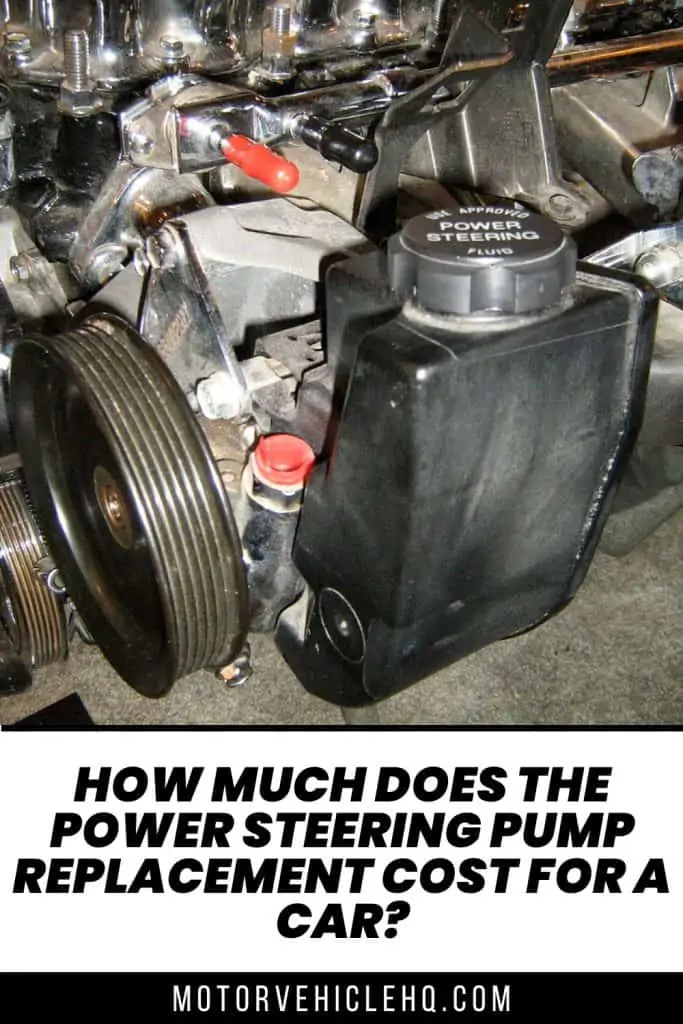

Jim Wicks is the founder of MotorVehicleHQ. With over two decades of experience in the automotive industry and a degree in Automotive Technology, Jim is a certified car expert who has worked in various roles ranging from a mechanic, car dealership manager, to a racing car driver. He has owned more than 20 cars over the past 15 years. Ask him about any vehicle you see on the road and he can tell you the make, model and year. He loves the aesthetics of all things cars, and keeps his vehicles in pristine condition.
In his free time, Jim enjoys getting his hands dirty under the hood of a classic car or taking long drives along the country roads. His favorite car? A 1967 Shelby GT500, a true classic that, according to Jim, “represents the pure essence of American muscle.”

